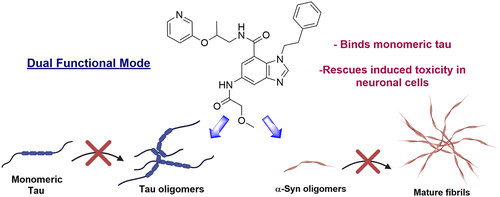当前位置:
X-MOL 学术
›
ACS Chem. Neurosci.
›
论文详情
Our official English website, www.x-mol.net, welcomes your
feedback! (Note: you will need to create a separate account there.)
Dual Targeting of Monomeric Tau and α-Synuclein Aggregation: A New Multitarget Therapeutic Strategy for Neurodegeneration.
ACS Chemical Neuroscience ( IF 4.1 ) Pub Date : 2020-06-24 , DOI: 10.1021/acschemneuro.0c00281 Moustafa T Gabr 1 , Francesca Peccati 2, 3
ACS Chemical Neuroscience ( IF 4.1 ) Pub Date : 2020-06-24 , DOI: 10.1021/acschemneuro.0c00281 Moustafa T Gabr 1 , Francesca Peccati 2, 3
Affiliation

|
Development of efficient multitargeted therapeutic strategies is crucial in facing the multifaceted nature of neurodegenerative diseases. Parkinson’s disease (PD) and Alzheimer’s disease (AD), the two most common neurodegenerative disorders, share a common hallmark of accumulation of misfolded protein aggregates which are Lewy bodies (LBs) and neurofibrillary tangles (NFTs), respectively. Tau protein and α-synuclein (α-syn), the precursors of LBs and NFTs, have demonstrated synergistic aggregation and neurotoxicity in both in vitro and in vivo models. Herein, we validate for the first time dual targeting of monomeric tau and α-syn aggregation as an efficient platform for development of multitarget therapeutics for neurological disorders. Cellular fluorescence resonance energy transfer (FRET)-based high-throughput screening for tau-binding compounds, followed by additional screening of the hits for their ability to impede α-syn aggregation identified MG-2119 as a potential lead. The high binding affinity of MG-2119 to monomeric tau was verified using cellular FRET assay, isothermal titration calorimetry (ITC), surface plasmon resonance (SPR), and microscale thermophoresis (MSH). Moreover, MG-2119 inhibited α-syn aggregation as revealed by thioflavin T (ThT) assay and dynamic light scattering (DLS) measurements. Interestingly, MG-2119 was capable of rescuing combined tau and α-syn-induced cytotoxicity in SH-SY5Y neuroblastoma cells in a dose-dependent manner. Less pronounced cell-rescuing effects were observed for single-targeted tau and α-syn aggregation inhibitors showcasing the superiority of the multitargeted approach described in this study. The satisfactory pharmacokinetic profile and low toxicity of MG-2119 hold promise for future optimization to develop potential therapeutics for neurological disorders.
中文翻译:

Tau单体和α-突触核蛋白聚集的双重靶向:神经变性的新的多靶点治疗策略。
发展有效的多目标治疗策略对于面对神经退行性疾病的多面性至关重要。帕金森氏病(PD)和阿尔茨海默氏病(AD)是两种最常见的神经退行性疾病,它们具有错误折叠的蛋白质聚集体累积的共同特征,分别是路易体(LB)和神经原纤维缠结(NFT)。Tau蛋白和α-突触核蛋白(α-syn)(LB和NFT的前体)在体内和体外均表现出协同聚集和神经毒性作用楷模。在本文中,我们首次验证了单体tau和α-syn聚集体的双重靶向,将其作为开发神经疾病多靶点疗法的有效平台。基于细胞荧光共振能量转移(FRET)的高通量筛选tau结合化合物,然后针对其阻碍α-syn聚集的能力进行额外筛选,确定MG-2119是潜在的先导。MG-2119对单体tau的高结合亲和力已通过细胞FRET分析,等温滴定量热法(ITC),表面等离振子共振(SPR)和微尺度热泳(MSH)进行了验证。此外,如硫黄素T(ThT)测定和动态光散射(DLS)测量所揭示的,MG-2119抑制α-syn聚集。有趣的是 MG-2119能够以剂量依赖的方式挽救SH-SY5Y神经母细胞瘤细胞中联合的tau和α-syn诱导的细胞毒性。对于单靶tau和α-syn聚集抑制剂,观察到不太明显的细胞拯救作用,显示了本研究中描述的多靶点方法的优越性。MG-2119令人满意的药代动力学特征和低毒性为未来的优化开发神经病潜在疗法提供了希望。
更新日期:2020-07-15
中文翻译:

Tau单体和α-突触核蛋白聚集的双重靶向:神经变性的新的多靶点治疗策略。
发展有效的多目标治疗策略对于面对神经退行性疾病的多面性至关重要。帕金森氏病(PD)和阿尔茨海默氏病(AD)是两种最常见的神经退行性疾病,它们具有错误折叠的蛋白质聚集体累积的共同特征,分别是路易体(LB)和神经原纤维缠结(NFT)。Tau蛋白和α-突触核蛋白(α-syn)(LB和NFT的前体)在体内和体外均表现出协同聚集和神经毒性作用楷模。在本文中,我们首次验证了单体tau和α-syn聚集体的双重靶向,将其作为开发神经疾病多靶点疗法的有效平台。基于细胞荧光共振能量转移(FRET)的高通量筛选tau结合化合物,然后针对其阻碍α-syn聚集的能力进行额外筛选,确定MG-2119是潜在的先导。MG-2119对单体tau的高结合亲和力已通过细胞FRET分析,等温滴定量热法(ITC),表面等离振子共振(SPR)和微尺度热泳(MSH)进行了验证。此外,如硫黄素T(ThT)测定和动态光散射(DLS)测量所揭示的,MG-2119抑制α-syn聚集。有趣的是 MG-2119能够以剂量依赖的方式挽救SH-SY5Y神经母细胞瘤细胞中联合的tau和α-syn诱导的细胞毒性。对于单靶tau和α-syn聚集抑制剂,观察到不太明显的细胞拯救作用,显示了本研究中描述的多靶点方法的优越性。MG-2119令人满意的药代动力学特征和低毒性为未来的优化开发神经病潜在疗法提供了希望。











































 京公网安备 11010802027423号
京公网安备 11010802027423号